 |
 |
 |
Part 3 (back to Part 2) NOVA: How fast do they swim? Klimley: About a yard per second when they're just cruising. That's kind of a magic number for most large fish. However, they can move quickly when they want to. I was once at the surface playing low-frequency sounds over a speaker to attract sharks. A hammerhead shot up from beneath me, rushing at me at perhaps 30 feet a second before he suddenly turned around. A very fast burst of speed. Many fish do that sort of thing—they're near the bottom, and they make a dash to the surface because it minimizes the profile prey have of them. But that's uncommon behavior among hammerheads. They're not a species that chases down prey such as white sharks do with seals or makos do with mackerel. Rather, they're feeding on schools of bioluminescing squid at night, perhaps making little dashes here and there but not prolonged pursuits.
Klimley: It may have something to do with mating. Hammerhead schools are primarily formed of females. They range in size from sub-adult to adult, and there's a dominance hierarchy among them. The largest, physically fit, more fecund females force the smaller ones out of the center of the school, into which males dash to find a mate. It's a form of intra-sexual selection that ensures that males pair with the biggest and baddest females—namely, those that are going to have the most young. It's amazing to me how structured and predictable behavior is at times.
Klimley: Three things. First, where do they go when they leave the seamount for good—not just for the night—as they do every year. When do they leave? How far do they go? Do they have a chronological set of way points at which they stop? I suspect that they don't just go anywhere. They go to a specific place at a specific time and then go to the next place at a specific time and then the next place, and they do this together. I'd be very interested to learn more about that.
Photos: (1,3-6,8-12) ©Howard Hall; (2) ©Flip McKlin; (7) ©Michele Hall; (13) ©Brad Kurtz. Cocos Island | Sharkmasters | World of Sharks | Dispatches E-mail | Resources | Site Map | Sharks Home Editor's Picks | Previous Sites | Join Us/E-mail | TV/Web Schedule | About NOVA Watch NOVAs online | Teachers | Site Map | Shop | Search | To Print PBS Online | NOVA Online | WGBH © | Updated June 2002 |
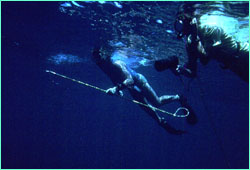 Klimley
carries the dart tag while Don Nelson operates the telemetry system.
Klimley
carries the dart tag while Don Nelson operates the telemetry system.
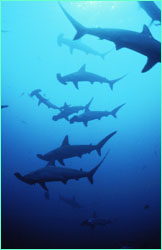 Schooling may aid males in choosing a
mate.
Schooling may aid males in choosing a
mate.
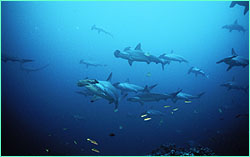 Where do hammerheads go when they leave Cocos Island
for good?
Where do hammerheads go when they leave Cocos Island
for good?
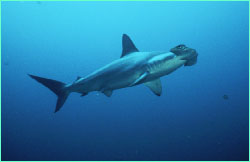 Though sometimes seen alone, hammerheads
prefer the company of others.
Though sometimes seen alone, hammerheads
prefer the company of others.
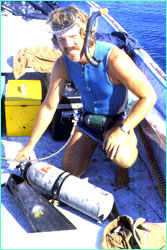 A pony bottle at the ready, Pete
Klimley readies himself for another plunge.
A pony bottle at the ready, Pete
Klimley readies himself for another plunge.